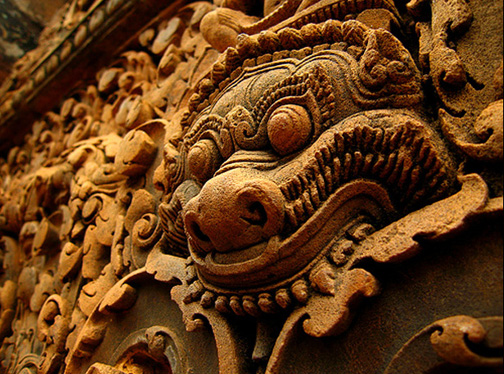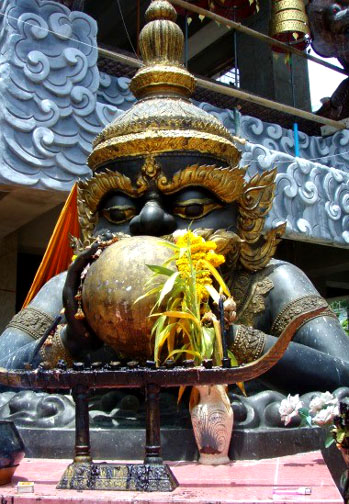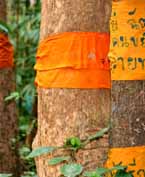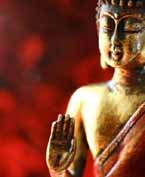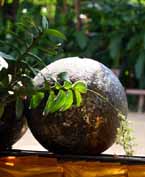Tags
(Regardless of your purpose in visiting Thailand, you can not escape the country’s religious beliefs; Buddhism plays an integral part in the peoples’ daily lives and is evident where ever you go. Temples and shrines are a common sight throughout the Kingdom. It is difficult, and would be a shame, for any tourist to not visit at least one wat during their holiday. And though many appear to look alike, each is unique in its own way, providing visitors a never ending opportunity for an exceptional cultural experience when visiting Thai places of worship during their travels.
You do not need to know a thing about Buddhism to appreciate the numerous pieces of art found in Thailand’s wats. On the other hand, a modicum of knowledge can make your visit that much more enjoyable.
I am not a follower of Buddha, and certainly no expert on Buddhism. But I have come to know a bit about the religion, and a bit about the Buddhist images most frequently seen in Thailand. I’ll share my limited knowledge with you in this series of posts, not to convert or enlighten but rather to provide a small glimpse of the religion to provide travellers a basic understanding that can add to the experience of visiting a wat in Thailand.)
When I run across a new or unusual piece of Buddhist imagery at a wat in Thailand, I usually ask my friend Noom for an explanation. That can be a hit or miss proposition. Sometimes he provides a fairly detailed answer, others a rather curt and abrupt one. The latter is either due to his belief that I should already know this stuff, or that his English skills are not up to allow him to give me the whole story. Such was the case when I asked about the statue pictured above. All I got from him in reply to my query was, “Eat moon.”
Okay. That certainly explained what was happening, but didn’t do much in the way of explaining the popularity of the image or its inclusion at the wats I’d seen it at. But a cool idea in any case. I have not run across this deity as often at wats as I have at markets. It appears to be popular, at least as an amulet for some Thais. Noom’s brief answer meant turning from his religion to one of my gods, Google, for a better idea of why the moon was being eaten. And why Buddhists cared.
You’d think that would be a easy search offering up a quick answer. It wasn’t. And I’m pretty adept at search phrases. I ended up backtracking from a similar photo I found on Google Images, which eventually led me to the term I needed for a better search: Phra Rahu, the name of the deity, which not surprisingly is a Hindu god assimilated into Thai Buddhist belief. And damn if he’s not cool!
In Buddhism, Rahu is the mythical god of darkness, one of the krodhadevatas (terror-inspiring gods). He comes from Hindu myth and his story is that during the Samudra Manthan, Rahu drank some divine nectar, but before the nectar could pass his throat Vishnu cut off his head. Why is not important. What is is that Rahu’s head remained immortal and occasionally swallows the sun or the moon, causing eclipses. According to Thai beliefs, the only way to prevent disaster is to scare Rahu away or placate him with offerings.
To ward off bad luck associated with Rahu’s attempts to devour the moon, or sun, believers make offerings of black flowers, black joss sticks, black candles . . . black is definitely the color of Rahu. So is the number 8, as it represents all earthly things. So there are eight traditional offerings made at shrines to Rahu; each have a specific purpose:
Black grapes are for good business.
Black liqueur is for courage to risk or invest.
Black coffee is to get whatever you wish for.
Black jelly brings patience and graceful thought.
Black beans promote progress.
Black sticky rice is for wealth and love from family.
Black Thai cake brings rewards, success and good luck.
Black fermented eggs ensures successful contact or errands.
Phra Rahu is not just prayed to during eclipses, however. As the legendary master of deception, cheaters, pleasure seekers, operators in foreign lands, drug dealers, poison dealers, and those committing insincere and immoral acts, he holds sway over a lot of negative areas of human existence. Told ya he was cool. Thais make offerings to get on his good side to ward off negativity, repel bad luck, and as a form of protection. A lot of white collar workers and government officials visit shrines to Rahu to help to ward off backstabbers, gossip, and to deal with offices politics.
Phra Rahu’s image is also a popular protective amulet and sacred tattoo (sak yant). It is believed his image will change bad thing to good thing: Phra Rahu will eat all of your bad luck. These amulets and yants also offer protection from evil spirits, and bring prosperity, money, and good luck. Rahu seems to be a more popular talisman than he does in statutory form at wats.
There is a shrine to Phra Rahu in Wat Traimet near Chinatown in Bangkok. Another Phra Rahu statue is at the Chinese Junk shaped Wat Yannawa, near the Saphan Taksin sky train station. Since discovering what he is all about, when I run across his image at a wat now I’m always pleased. Noom doesn’t appear to share my enthusiasm. His personal god is Ganesha; I’m not sure if it is that he doesn’t approve of Rahu, or just that he wants my attention to be directed to where he feels it’ll do more good.
I try to keep in mind that what is myth to me is religious belief to him, but can’t hide that Rahu holds a greater attraction to me than Ganesha does. Now that Noom knows that I know who Rahu is and the offerings associated with him, whenever I order coffee – and specify black coffee – he gives me a quick look full of suspicion.
Related Posts You Might Enjoy:


